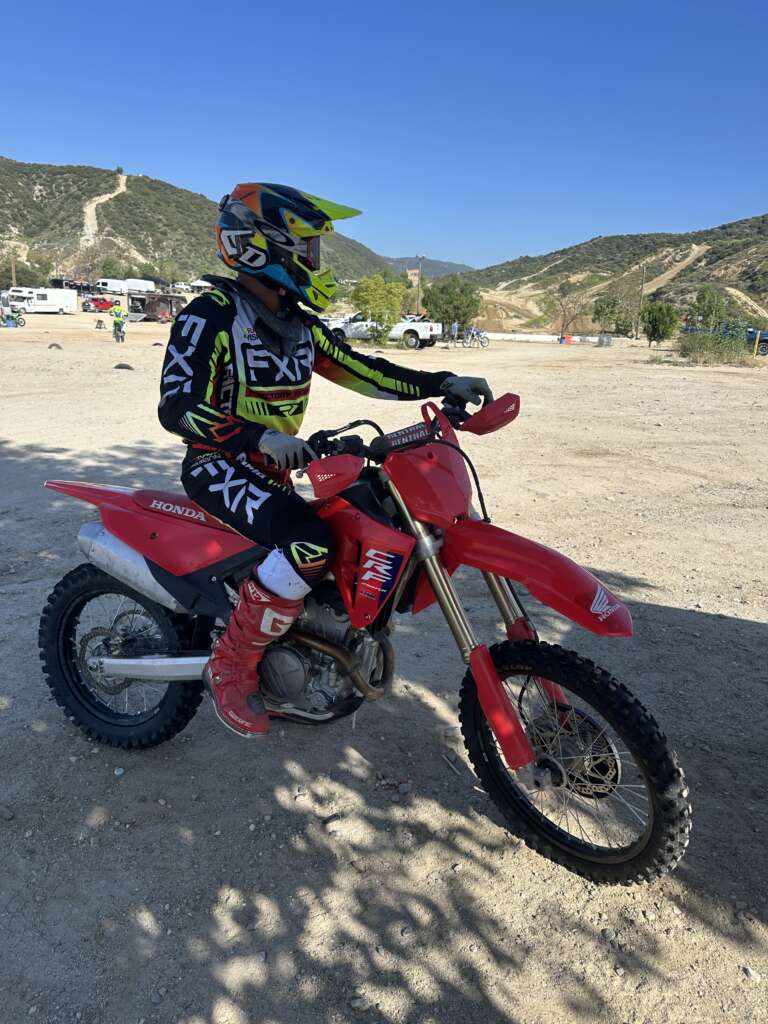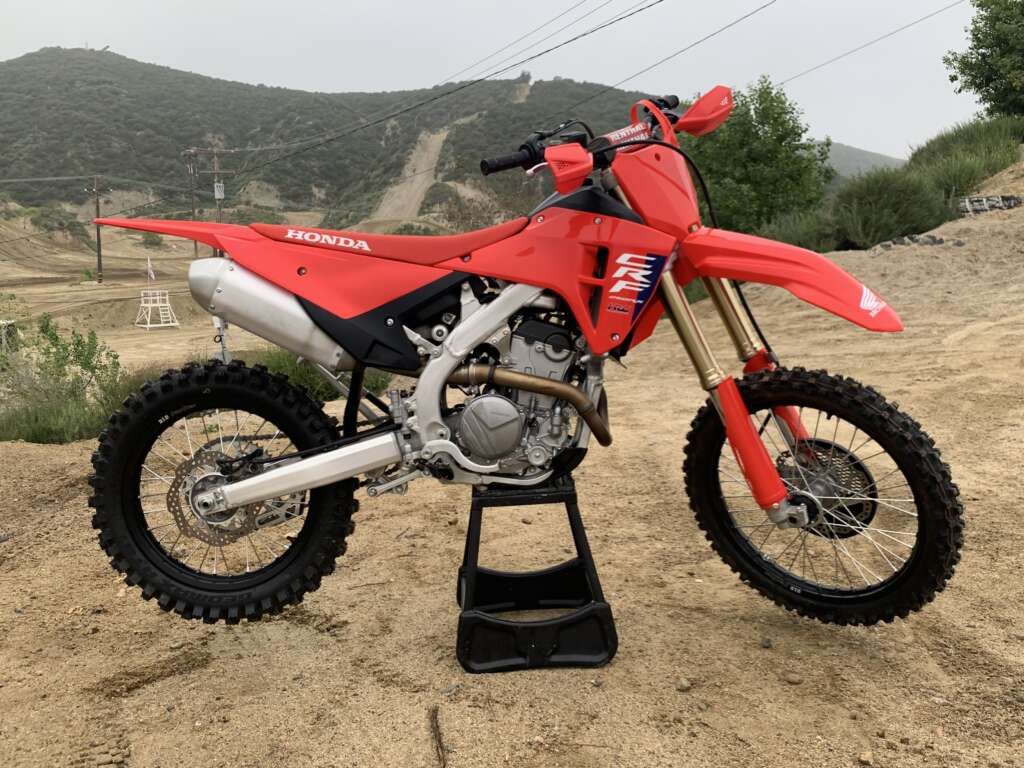Written By: Gardner Tarlow
I have to be honest; I’m a fair-weather tester. What I mean by that is since I’m not employed within the industry or being paid to test any certain bike, I’m usually testing something I really want to ride. With that being said, when Kris asked me to test the new Honda CRF250RX, I wasn’t overly excited. I hadn’t heard anything special about previous RX models and assumed the CRF250RX would be old technology with bold new graphics compared to the all-new CRF250R. Without researching the CRF250RX, I picked it up and immediately focused on some minor visual aspects I didn’t like. To be perfectly honest, I had not ridden an off-road Honda in many years and in hindsight, I was looking for things to not like, which was unfair. That phrase, “Don’t judge a book by its cover?” Never truer than with the new CRF250RX.
We have all heard about the 2025 CRF250R motocross bike and how improved it is over its predecessors. Well, with just a handful of modifications, Honda has provided us with an all new offroad version CRF250RX. The new RX receives the same updates that the 250R received including the chassis, suspension, and engine updates for improved performance and power delivery. The chassis receives an updated frame, new subframe mounting points, and new linkage. The suspension has a slightly softer dampening that allows the bike to perform in off-road terrain that is more in line with GNCC performance compared to aggressive motocross. The fork features new spring, and kit-fork-inspired bending control valves. The motor is the same 250R motor with an ECU and redesigned airbox that has been tuned for smoother power, which provides 3 different maps to assist with different types of riding terrain, allowing for improved power performance across a wider range of conditions. The CRF250RX also comes with an off-road 18-inch rear wheel, trusty kickstand, handguards, and a larger fuel tank.

First ride impressions were quite surprising. Since I ride a lot of Glen Helen, I decided to dial in the suspension and get a sense of what the bike is about at my local stomping grounds. Honda’s stock recommended suspension settings for the fork is C-10, R-14, with fork height 5mm and shock is HS-2 1/3, LS-10, R-15, with sag at 105mm. When I received the bike, its set up had the forks at 6mm and the sag was already at 102mm. Being the lazy mechanic I can be and assuming the spring would soften after a few rides, I left the sag at 102mm. My first immediate impression on the track was that this bike cornered really well. Despite the AT81 tire, the bike felt good on edge entering area 1 of the corner, was stable through area 2-mid-corner and had no difficulty remaining on the inside line of the exit of corners even when the exit of the rut flattened out or opened up in area 3. The bike seemed to want to just fall over and rail corners. The bike didn’t seem to squat mid corner under acceleration or upset area 3 of the turn. The 18” rear wheel softens up acceleration bumps exiting corners, making the bike a pleasure to rail choppy ruts. In general, the more motos I rode and did not feel or appreciate any significant straight-line instability, the more I really appreciated the Hondas cornering prowess. During a recheck of sag after approximately 6 plus hours, my sag was now 104mm and I believe the chassis was the major driving mechanism for its front-end steering and handling characteristic. With that bit of praise going towards the aluminum chassis for cornering, I did battle with more extensor forearm arm fatigue (not arm pump) during each moto while riding the CRF250RX. I wasn’t certain if this was due to the aluminum chassis, triple clamps, bars or Honda grips that I have minimal use and experience with. Whatever the cause, I put it on the back burner to figure out later.
The motor is the same as the CRF250R with the same transmission and final gearing. The only difference is the ECU maps. The CRF 250RX ECU has 3 maps: map 1 is stock, 2 is detuned, and 3 is aggressive. For track purposes map 3 is the optimal map that will allow you to dice with other bikes on the track. I would be curious to know how map 3 differs from the CRF250R stock ECU aggressive setting. Map 3 on the RX has a good front side but could use a bit more punchiness down low when coming out of corners. The motor seems to rev up quickly and the mid to top end is where this map 3 performs really well with good overrev. Map 1 is similar in its pattern but with a tad softer performance everywhere and less overrev. Map 2, I believe, is designed for more technical off-road or an introductory rider use. I was able to appreciate map 2 in some very tight, dry, slow single tracks and it worked well with a linear roll-on power that was easy to manage. I used map 3 for all moto rides and for the most part map 1 for tight fast single track.
During the next few outings, I managed to ride some different tracks I frequent, as well as some different tight fast (dry) single track. The CRF250RX as an offroad bike is a lot of fun to ride. It has good stability and performs well in tight single track with its front-end bias steering. I eventually changed the Dunlop AT81 front tire for a mildly used Dunlop MX34. This change provided even more confidence with the Honda when the tire was on edge and on off camber sections of both tracks or trails. The Showa forks do a nice job absorbing small hits from rocky uneven ground as well as larger hits from square edge rocks, logs and G-outs. The rear shock is well mannered and doesn’t do anything to surprise or disrupt the bikes performance. I again noticed a general sense of more arm fatigue when riding these familiar off-road loops and other familiar tracks that I don’t typically fatigue on. This arm fatigue had me thinking again about the aluminum chassis compared to my mostly steal entourage of bikes I own.

As I put more hours on the CRF250RX the final suspension changes I made were to soften the fork from C-10 to 11, R-14 to 13 and decrease shock HS from 2 1/3 to 2 2/3. Although my arm fatigue has gotten better with each subsequent ride and tweaking of bars, I believe the aluminum chassis is what I’m feeling. I don’t know how much aluminum frames stretch, if at all, but this feeling is similar to what I’ve appreciated in the past when a steel frame was new.
In an attempt to reduce this tension in my arms that I was feeling through the bars, I tested with the triple clamp pinch bolt torque settings. Decreasing both top and bottom pinch bolts from stock of 16/15lb to 12/11lb which was an improvement and eventually 12/10lb (16/13.5Nm) was optimal for myself. This seemed to help in general with less rigidity feeling through my hands and arms as well as provided a softer feeling on slap down landings. Additionally, I felt this also helped front wheel compliance or general touch on lean angle. After appreciating how the lower torque settings on the pinch bolts improved the rigidity feeling with the Honda, I asked Kris about options for reducing torque specs on the motor mounts.
Kris provided me a spec sheet for the 2024 CRF450R they tested and indicated this would be the same for the 2025 CRF250R and RX. Kris indicated that despite the small reductions in torque settings, when they went even lower with torque settings, the bike was negatively affected with cornering. I used all the same lower torque settings on the 2025 CRF250RX chassis and although I was able to appreciate the triple clamp pinch bolt adjustment at 12/10lb (stock 16/15lb), I wasn’t certain if I could actually appreciate improvements in the chassis adjustments alone, the same way I did with the triple clamp pinch bolts. In general, after switching chassis bolts back and forth, I believe the overall combined effect was an improvement in the chassis rigidity using the modified torque specs and I would absolutely continue to run these specs if this was my bike. See Keeferinctesting.com and search, 2024 CRF450R Baseline settings and modifications, for spec sheet.
The Honda CRF250RX has a lot of aftermarket options that can be added for that personal touch you may want for your bike. The cable clutch allows for good actuation and although its pull isn’t bad, it seems dated after riding so many bikes with butter smooth hydraulic clutches. A hydraulic clutch application is available as a Honda aftermarket product if hydraulics is what you want. The 2.1-gallon gas tank design is not the most appealing tank out there and has a high center of gravity as well as much wider tank shrouds to accommodate the extra gas. The tank is not the end of the world but you know when you’re up close on the tank as you feel your knees push out. When the tank is full with gas, the high center of gravity affects cornering very slightly compared to when the tank is only half full, which is very subtle but appreciable. Being Honda, it would have been nicer had there been more thought and design around a lower center of gravity tank as well as a tank similar in width to the CRF250R platform. There are aftermarket tank options available that can meet those needs if one feels inclined. The skid plate, front brake rotor guard, and hand guards are all nice additions. With the ECU and its 3 maps, it would have been nice to have the actual 250R main moto map as well as an offroad race map and a map designed for tight technical offroad enduro, which is what I believe the current stock map 2 is intended for.
There are a lot of great things about this Honda. It’s nice that the Japanese brands are returning some focus on producing offroad specific competitive race bikes to the market. If you’re part of the Red Rider family or just wanting to try something new, this 2025 CRF250RX is a competitive offroad race and trail bike. Be it practice track days, weekend racing, riding in the desert or out in the hills, the Honda CRF250RX can take you there and back.
Honda CRF250RX $8,699
Yamaha YZ250FX $9099
Kawasaki KX250X $9,099
KTM 250XC-F $10,849
